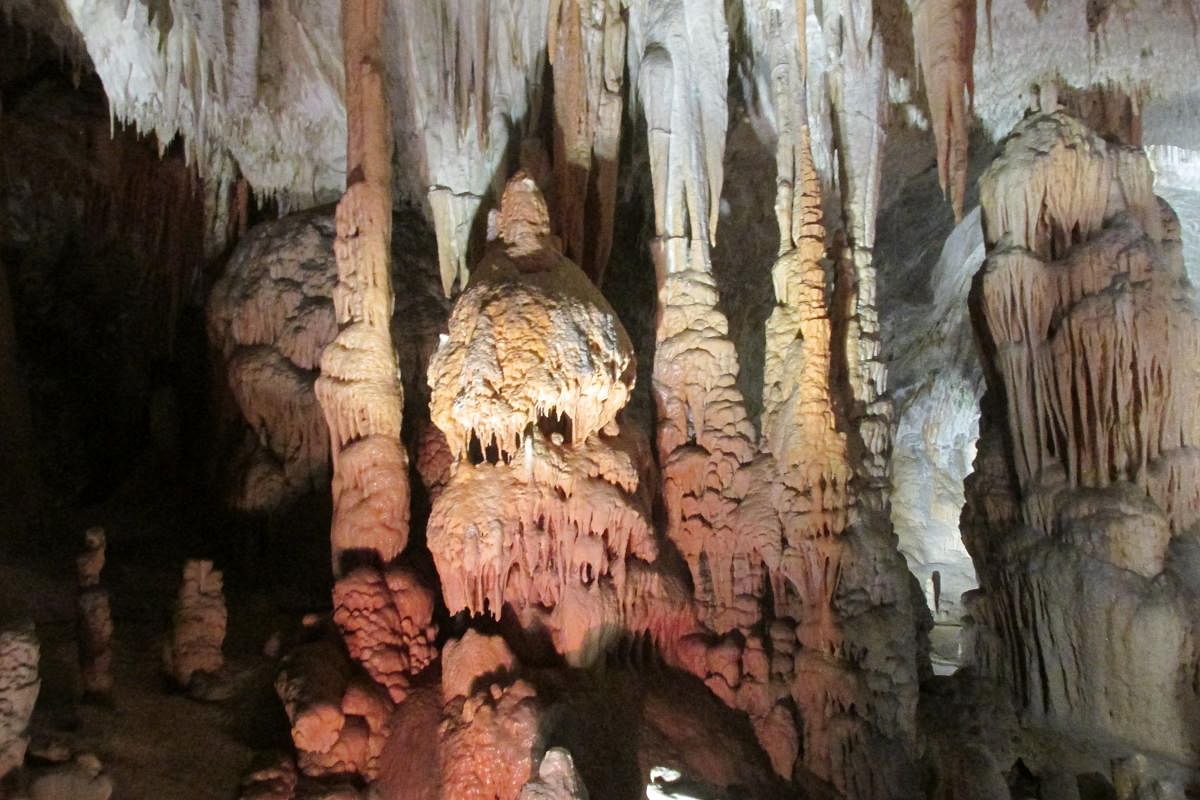
How does it feel to explore miles in a world of caves surrounded by limestone sculptures shaped through millions of years? And come across an amphibian salamander called Olm that never sees the light of day and is white in colour and can live without food for 10 years? A trip from Ljubljana, capital of Slovenia, through green meadows and forests, hardly prepared me for the encounter with this dark, but fascinating Karst world at Postojna.
The topography of Karst is formed by dissolving of soluble rocks like limestone, dolomite, gypsum etc. by underground drainage systems. The 24 km long Postojna cave system has been formed by interaction with the Pivka River that enters the subterranean level at the cave mouth. The water continues to work on the soft stones still but at an excruciatingly slow pace, perhaps a few millimeters in hundreds of years. Karst features may occur only at subsurface levels and can be totally absent above ground.
Deep down
As we entered this ‘underworld’, we were led to an open-top train, the world’s first railway in an underground cave which was opened in 1872 . The temperature here is a constant 10 degree Celsius and so out came the jackets and scarves to keep away the draught. A major tourist attraction now, the operation here by the authorities, a private company, is run with clock-work efficiency. Lighting at specific corners bring out the beauty of nature-made sculptures of the stalagmites.
The cameras can hardly do justice to the amazing formations with their intricate designs. Like the pristine white ‘Brilliant’, a 5-meter tall formation with ornamentations around. As the train chugged by slowly, webs of
stalactites hanging from the ceiling seemed to touch our heads. Once we
disembarked at the ‘station’, a 3.7 km ride, the walks started in semi-darkness which covered more than one kilometre. There are steep gradients at places and I had to admire the elderly visitors with walking sticks negotiating the bends.
Thankfully, the walkways are laid with a hard surface and despite water dripping at places it is not slippery.
An English speaking guide explained about the history of the discovery of the caves. The locals always knew about its existence but feared to enter as there was myths of dragons living there, perhaps thinking the Olms to be babies of dragons with their unusual shape. The caves were first described in 17 th Century by Johann W Von Valvasor who pioneered the study of Karst geology. Inside, explorers, however, found graffiti from the 13th century pointing to earlier human habitation.
In 1818, the cave was being prepared for a visit by the emperor of Austria- Hungary, when a local named Luka Cec, a lamplighter, accidentally discovered a new branch of the cave and declared to his co-workers, who had thought he had died after disappearing from view: “Here is a new world, here is paradise.” Next year, Archduke Ferdinand visited the caves after which the caves became popular as a tourist destination. Sadly, coming from a poor family, he did not get the recognition due to him in the hierarchal world, though he continued working in the cave till his death. On the walking tour sometimes with narrow passages and encircled by huge walls of stalagmites the guide also pointed out the Russian Bridge. During the First World War, Russian prisoners of war were made to construct this bridge to cover a chasm between two caves.
During the Second World War, German occupying forces used the cave to store barrels of aircraft fuel but Slovene Partisans blew it up in 1944. The fire burned for a week. As I emerged to daylight outside, the past 90 minutes spent in the dark cave
complex seemed almost surreal.
Castle in the caves
A man-made marvel in the vicinity, again with a cave connection, waited to be explored next. The Predjama Castle, 800-years-old, is the world’s largest cave castle and listed in the Guinness World Records.
The castle is perched halfway up a 123-metre cliff with its entrance at the cave mouth. The Gothic-style castle was first built in 1274 by the Patriarch of Aquileia.
It was later rebuilt by its new owners, the Luegg family.
Its unique location contributes to making Predjama Castle the only completely preserved cave castle in Europe. No wonder it has been the locale of many film shoots.
Entering the castle gives a glimpse of the construction techniques and
inventiveness of its medieval builders, who built the refuge behind the entrance to the cave.
Its most well-known member was Erasmus who took on the rulers — the Habsburg family of Austria-Hungary, head-on. Fleeing their wrath he took refuge in the castle.
He was known as a robber baron, too but the locals regarded him as a Robin Hood character.
The royals sent their army to capture him but what puzzled them was how he resisted a year-long siege. They did not know that he built a secret passage widening an existing shaft through which the villagers supplied his family with foodstuff.
There are stories of how his men threw apples at the soldiers below from the castle window to taunt them. But ultimately, as it has happened in many instances throughout history, one of his servants betrayed him and he was killed.
The castle has now been turned into a museum. We climbed up the precarious steps to explore the living quarters of the Lueggs.
In one room medieval weapons are displayed. In the living quarters of the family, lifelike reproductions help to understand the way they lived. The kitchen, the room where the baron held his court, all give an idea of a lifestyle centuries ago.
In 1991, restorers discovered goblets, silver-gilt items, windmill cups, etc. which were hidden in one of the chambers. They are now displayed in the Notranjka Museum in Postojna.
Trans World Features